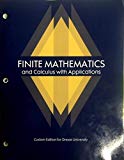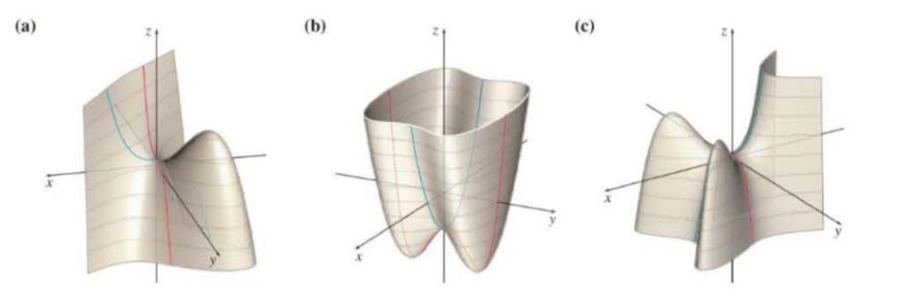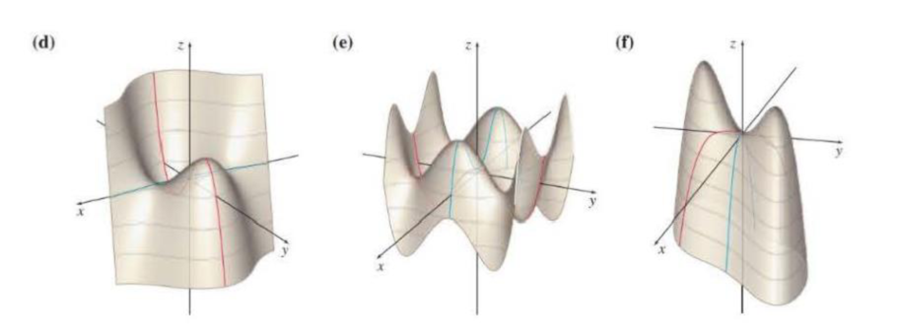
Finite Mathematics and Calculus with Applications
1st Edition
ISBN: 9781323188361
Author: Margaret Lial
Publisher: Pearson Education
expand_more
expand_more
format_list_bulleted
Concept explainers
Textbook Question
Chapter 17.3, Problem 24E
Figures (a)–(f) show the graphs of the functions defined in Exercises 21–26. Find all relative extrema for each function, and then match the equation to its graph.
24.


Expert Solution & Answer
Want to see the full answer?
Check out a sample textbook solution
Students have asked these similar questions
Explain the conditions under which the Radius of Convergence of the Power Series is a "finite positive real number" r>0
This means that when the Radius of Convergence of the Power Series is a "finite positive real number" r>0, then every point x of the Power Series on (-r, r) will absolutely converge (x ∈ (-r, r)). Moreover, every point x on the Power Series (-∞, -r)U(r, +∞) will diverge (|x| >r). Please explain it.
Explain the conditions under which Radious of Convergence of Power Series is infinite. Explain what will happen?
Chapter 17 Solutions
Finite Mathematics and Calculus with Applications
Ch. 17.1 - For the function in Example 1, find f(2, 3)....Ch. 17.1 - Prob. 2YTCh. 17.1 - Prob. 3YTCh. 17.1 - Prob. 4YTCh. 17.1 - Prob. 1WECh. 17.1 - Prob. 2WECh. 17.1 - Prob. 3WECh. 17.1 - Prob. 4WECh. 17.1 - Prob. 5WECh. 17.1 - Prob. 6WE
Ch. 17.1 - Let f(x, y) = 2x 3y + 5. Find the following....Ch. 17.1 - Prob. 2ECh. 17.1 - Prob. 3ECh. 17.1 - Prob. 4ECh. 17.1 - Prob. 5ECh. 17.1 - Prob. 6ECh. 17.1 - Prob. 7ECh. 17.1 - Prob. 8ECh. 17.1 - Graph the first-octant portion of each plane. 9.2x...Ch. 17.1 - Prob. 10ECh. 17.1 - Prob. 11ECh. 17.1 - Prob. 12ECh. 17.1 - Prob. 13ECh. 17.1 - Prob. 14ECh. 17.1 - Prob. 15ECh. 17.1 - Prob. 16ECh. 17.1 - Prob. 17ECh. 17.1 - Prob. 18ECh. 17.1 - Prob. 19ECh. 17.1 - Prob. 20ECh. 17.1 - Prob. 21ECh. 17.1 - Prob. 22ECh. 17.1 - Match each equation in Exercises 2328 with its...Ch. 17.1 - Prob. 24ECh. 17.1 - Prob. 25ECh. 17.1 - Match each equation in Exercises 2328 with its...Ch. 17.1 - Prob. 27ECh. 17.1 - Prob. 28ECh. 17.1 - Prob. 29ECh. 17.1 - Prob. 30ECh. 17.1 - Prob. 31ECh. 17.1 - Prob. 32ECh. 17.1 - Prob. 33ECh. 17.1 - Prob. 34ECh. 17.1 - Production Find the level curve at a production of...Ch. 17.1 - Prob. 36ECh. 17.1 - Prob. 37ECh. 17.1 - Individual Retirement Accounts The multiplier...Ch. 17.1 - Individual Retirement Accounts The multiplier...Ch. 17.1 - Heat Loss The rate of heal loss (in watts) in...Ch. 17.1 - Prob. 41ECh. 17.1 - Prob. 42ECh. 17.1 - Pollution Intolerance According to research at the...Ch. 17.1 - Dengue Fever In tropical regions, dengue fever is...Ch. 17.1 - Prob. 45ECh. 17.1 - Prob. 46ECh. 17.1 - Prob. 47ECh. 17.1 - Prob. 48ECh. 17.1 - Prob. 49ECh. 17.1 - Prob. 50ECh. 17.1 - Prob. 51ECh. 17.2 - Prob. 1YTCh. 17.2 - Prob. 2YTCh. 17.2 - Prob. 3YTCh. 17.2 - Prob. 4YTCh. 17.2 - Prob. 1WECh. 17.2 - Prob. 2WECh. 17.2 - Prob. 3WECh. 17.2 - Prob. 4WECh. 17.2 - Prob. 5WECh. 17.2 - Prob. 6WECh. 17.2 - Prob. 7WECh. 17.2 - Prob. 8WECh. 17.2 - Prob. 1ECh. 17.2 - Prob. 2ECh. 17.2 - Prob. 3ECh. 17.2 - Prob. 4ECh. 17.2 - Prob. 5ECh. 17.2 - Prob. 6ECh. 17.2 - Prob. 7ECh. 17.2 - Prob. 8ECh. 17.2 - Prob. 9ECh. 17.2 - Prob. 10ECh. 17.2 - Prob. 11ECh. 17.2 - Prob. 12ECh. 17.2 - Prob. 13ECh. 17.2 - Prob. 14ECh. 17.2 - Prob. 15ECh. 17.2 - Prob. 16ECh. 17.2 - Prob. 17ECh. 17.2 - Prob. 18ECh. 17.2 - Prob. 19ECh. 17.2 - Prob. 20ECh. 17.2 - Prob. 21ECh. 17.2 - Prob. 22ECh. 17.2 - Prob. 23ECh. 17.2 - Prob. 24ECh. 17.2 - Prob. 25ECh. 17.2 - Prob. 26ECh. 17.2 - Prob. 27ECh. 17.2 - Prob. 28ECh. 17.2 - Prob. 29ECh. 17.2 - Prob. 30ECh. 17.2 - Prob. 31ECh. 17.2 - Prob. 32ECh. 17.2 - Prob. 33ECh. 17.2 - Prob. 34ECh. 17.2 - Prob. 35ECh. 17.2 - Prob. 36ECh. 17.2 - Prob. 37ECh. 17.2 - Prob. 38ECh. 17.2 - Prob. 39ECh. 17.2 - Prob. 40ECh. 17.2 - Find fx(x,y,z),fy(x,y,z),fz(x,y,z), and fyz(x,y,z)...Ch. 17.2 - Prob. 42ECh. 17.2 - Prob. 43ECh. 17.2 - Prob. 44ECh. 17.2 - Business and Economics 45.Manufacturing Cost...Ch. 17.2 - Prob. 46ECh. 17.2 - Prob. 47ECh. 17.2 - Prob. 48ECh. 17.2 - Prob. 49ECh. 17.2 - Prob. 50ECh. 17.2 - Prob. 51ECh. 17.2 - Prob. 52ECh. 17.2 - Prob. 53ECh. 17.2 - Prob. 54ECh. 17.2 - Prob. 55ECh. 17.2 - Prob. 56ECh. 17.2 - Prob. 57ECh. 17.2 - Prob. 58ECh. 17.2 - Prob. 59ECh. 17.2 - Prob. 60ECh. 17.2 - Prob. 61ECh. 17.2 - Prob. 62ECh. 17.2 - Drug Reaction The reaction to x units of a drug t...Ch. 17.2 - Prob. 64ECh. 17.2 - Prob. 66ECh. 17.2 - Prob. 67ECh. 17.2 - Prob. 68ECh. 17.2 - Gravitational Attraction The gravitational...Ch. 17.2 - Velocity In 1931, Albert Einstein developed the...Ch. 17.2 - Prob. 71ECh. 17.3 - Prob. 1YTCh. 17.3 - Prob. 2YTCh. 17.3 - Prob. 1WECh. 17.3 - Prob. 2WECh. 17.3 - Prob. 1ECh. 17.3 - Prob. 2ECh. 17.3 - Prob. 3ECh. 17.3 - Prob. 4ECh. 17.3 - Prob. 5ECh. 17.3 - Prob. 6ECh. 17.3 - Prob. 7ECh. 17.3 - Prob. 8ECh. 17.3 - Prob. 9ECh. 17.3 - Prob. 10ECh. 17.3 - Prob. 11ECh. 17.3 - Prob. 12ECh. 17.3 - Prob. 13ECh. 17.3 - Prob. 14ECh. 17.3 - Prob. 15ECh. 17.3 - Prob. 16ECh. 17.3 - Prob. 17ECh. 17.3 - Prob. 18ECh. 17.3 - Prob. 19ECh. 17.3 - Prob. 20ECh. 17.3 - Prob. 21ECh. 17.3 - Prob. 22ECh. 17.3 - Prob. 23ECh. 17.3 - Figures (a)(f) show the graphs of the functions...Ch. 17.3 - Prob. 25ECh. 17.3 - Prob. 26ECh. 17.3 - Prob. 27ECh. 17.3 - Prob. 28ECh. 17.3 - Prob. 29ECh. 17.3 - Prob. 30ECh. 17.3 - Prob. 31ECh. 17.3 - Prob. 32ECh. 17.3 - Prob. 33ECh. 17.3 - Prob. 34ECh. 17.3 - Prob. 35ECh. 17.3 - Prob. 36ECh. 17.3 - Prob. 37ECh. 17.3 - Prob. 38ECh. 17.3 - Prob. 39ECh. 17.3 - Prob. 40ECh. 17.3 - Prob. 42ECh. 17.4 - Prob. 1YTCh. 17.4 - Prob. 1WECh. 17.4 - Prob. 2WECh. 17.4 - Find the relative maxima or minima in Exercises...Ch. 17.4 - Find the relative maxima or minima in Exercises...Ch. 17.4 - Find the relative maxima or minima in Exercises...Ch. 17.4 - Find the relative maxima or minima in Exercises...Ch. 17.4 - Find the relative maxima or minima in Exercises...Ch. 17.4 - Find the relative maxima or minima in Exercises...Ch. 17.4 - Find the relative maxima or minima in Exercises...Ch. 17.4 - Find the relative maxima or minima in Exercises...Ch. 17.4 - Find the relative maxima or minima in Exercises...Ch. 17.4 - Find the relative maxima or minima in Exercises...Ch. 17.4 - Prob. 11ECh. 17.4 - Find positive numbers x and y such that x + y = 48...Ch. 17.4 - Prob. 13ECh. 17.4 - Prob. 14ECh. 17.4 - Find the maximum and minimum values of f(x, y) =x3...Ch. 17.4 - Prob. 16ECh. 17.4 - Prob. 17ECh. 17.4 - Prob. 18ECh. 17.4 - Prob. 19ECh. 17.4 - Prob. 20ECh. 17.4 - Prob. 21ECh. 17.4 - Discuss the advantages and disadvantages of the...Ch. 17.4 - Prob. 23ECh. 17.4 - Prob. 24ECh. 17.4 - Prob. 25ECh. 17.4 - Prob. 26ECh. 17.4 - Prob. 27ECh. 17.4 - Prob. 28ECh. 17.4 - Prob. 29ECh. 17.4 - Prob. 30ECh. 17.4 - Prob. 31ECh. 17.4 - Prob. 32ECh. 17.4 - Prob. 33ECh. 17.4 - Prob. 34ECh. 17.4 - Prob. 35ECh. 17.4 - Prob. 36ECh. 17.4 - Prob. 37ECh. 17.4 - Prob. 38ECh. 17.4 - Prob. 39ECh. 17.4 - Prob. 40ECh. 17.4 - Prob. 41ECh. 17.4 - Prob. 42ECh. 17.5 - Prob. 1YTCh. 17.5 - Prob. 2YTCh. 17.5 - Prob. 3YTCh. 17.5 - Prob. 1WECh. 17.5 - Prob. 2WECh. 17.5 - Prob. 3WECh. 17.5 - Prob. 4WECh. 17.5 - Prob. 1ECh. 17.5 - Prob. 2ECh. 17.5 - Prob. 3ECh. 17.5 - Prob. 4ECh. 17.5 - Prob. 5ECh. 17.5 - Prob. 6ECh. 17.5 - Prob. 7ECh. 17.5 - Prob. 8ECh. 17.5 - Prob. 9ECh. 17.5 - Prob. 10ECh. 17.5 - Prob. 11ECh. 17.5 - Prob. 12ECh. 17.5 - Prob. 13ECh. 17.5 - Prob. 14ECh. 17.5 - Prob. 15ECh. 17.5 - Prob. 16ECh. 17.5 - Volume of a Coating An industrial coaling 0.1 in....Ch. 17.5 - Prob. 18ECh. 17.5 - Prob. 19ECh. 17.5 - Prob. 20ECh. 17.5 - Prob. 21ECh. 17.5 - Prob. 22ECh. 17.5 - Prob. 23ECh. 17.5 - Prob. 24ECh. 17.5 - Life Span As we saw in Exercise 62 of Section...Ch. 17.5 - Prob. 26ECh. 17.5 - Prob. 27ECh. 17.5 - Prob. 28ECh. 17.5 - Prob. 29ECh. 17.5 - Prob. 30ECh. 17.5 - Prob. 31ECh. 17.5 - Prob. 32ECh. 17.5 - Prob. 33ECh. 17.5 - Prob. 34ECh. 17.5 - Prob. 35ECh. 17.6 - Prob. 1YTCh. 17.6 - Evaluate 02[13(6x2y2+4xy+8x3+10y4+3)dy]dx and then...Ch. 17.6 - Prob. 3YTCh. 17.6 - Prob. 4YTCh. 17.6 - Prob. 5YTCh. 17.6 - Prob. 1WECh. 17.6 - Evaluate each definite integral. W2.23x+6dxCh. 17.6 - Prob. 3WECh. 17.6 - Prob. 4WECh. 17.6 - Prob. 5WECh. 17.6 - Prob. 6WECh. 17.6 - Prob. 1ECh. 17.6 - Prob. 2ECh. 17.6 - Prob. 3ECh. 17.6 - Prob. 4ECh. 17.6 - Prob. 5ECh. 17.6 - Prob. 6ECh. 17.6 - Prob. 7ECh. 17.6 - Prob. 8ECh. 17.6 - Prob. 9ECh. 17.6 - Prob. 10ECh. 17.6 - Prob. 11ECh. 17.6 - Prob. 12ECh. 17.6 - Prob. 13ECh. 17.6 - Prob. 14ECh. 17.6 - Prob. 15ECh. 17.6 - Prob. 16ECh. 17.6 - Prob. 17ECh. 17.6 - Prob. 18ECh. 17.6 - Prob. 19ECh. 17.6 - Prob. 20ECh. 17.6 - Prob. 21ECh. 17.6 - Prob. 22ECh. 17.6 - Prob. 23ECh. 17.6 - Prob. 24ECh. 17.6 - Prob. 25ECh. 17.6 - Prob. 26ECh. 17.6 - Prob. 27ECh. 17.6 - Prob. 28ECh. 17.6 - Prob. 29ECh. 17.6 - Prob. 30ECh. 17.6 - Prob. 31ECh. 17.6 - Prob. 32ECh. 17.6 - Prob. 33ECh. 17.6 - Prob. 34ECh. 17.6 - Prob. 35ECh. 17.6 - Prob. 36ECh. 17.6 - Prob. 37ECh. 17.6 - Prob. 38ECh. 17.6 - Prob. 39ECh. 17.6 - Prob. 40ECh. 17.6 - Prob. 41ECh. 17.6 - Prob. 42ECh. 17.6 - Prob. 43ECh. 17.6 - Use the region R with the indicated boundaries to...Ch. 17.6 - Prob. 45ECh. 17.6 - Prob. 46ECh. 17.6 - Prob. 47ECh. 17.6 - Prob. 48ECh. 17.6 - Prob. 49ECh. 17.6 - Prob. 50ECh. 17.6 - Prob. 51ECh. 17.6 - Prob. 52ECh. 17.6 - Prob. 53ECh. 17.6 - Prob. 54ECh. 17.6 - Prob. 55ECh. 17.6 - Prob. 56ECh. 17.6 - Prob. 57ECh. 17.6 - Prob. 58ECh. 17.6 - Prob. 59ECh. 17.6 - Prob. 60ECh. 17.6 - Prob. 61ECh. 17.6 - Prob. 62ECh. 17.6 - Prob. 63ECh. 17.6 - Prob. 64ECh. 17.6 - Prob. 65ECh. 17.6 - Prob. 66ECh. 17.6 - Prob. 67ECh. 17.6 - Prob. 68ECh. 17.6 - Prob. 69ECh. 17.6 - Time In Exercise 39 of Section 17.3, we saw that...Ch. 17.6 - Profit In Exercise 38 of Section 17.3, we saw that...Ch. 17 - Determine whether each of the following statements...Ch. 17 - Prob. 2RECh. 17 - Prob. 3RECh. 17 - Prob. 4RECh. 17 - Prob. 5RECh. 17 - Prob. 6RECh. 17 - Prob. 7RECh. 17 - Prob. 8RECh. 17 - Prob. 9RECh. 17 - Prob. 10RECh. 17 - Prob. 11RECh. 17 - Prob. 12RECh. 17 - Prob. 13RECh. 17 - Prob. 14RECh. 17 - Prob. 15RECh. 17 - Prob. 16RECh. 17 - Prob. 17RECh. 17 - Prob. 18RECh. 17 - Prob. 19RECh. 17 - Prob. 20RECh. 17 - Prob. 21RECh. 17 - Prob. 22RECh. 17 - Prob. 23RECh. 17 - Prob. 24RECh. 17 - Prob. 25RECh. 17 - Prob. 26RECh. 17 - Prob. 27RECh. 17 - Prob. 28RECh. 17 - Prob. 29RECh. 17 - Prob. 30RECh. 17 - Prob. 31RECh. 17 - Prob. 32RECh. 17 - Prob. 33RECh. 17 - Prob. 34RECh. 17 - Prob. 35RECh. 17 - Prob. 36RECh. 17 - Prob. 37RECh. 17 - Prob. 38RECh. 17 - Prob. 39RECh. 17 - Prob. 40RECh. 17 - Prob. 41RECh. 17 - Prob. 42RECh. 17 - Prob. 43RECh. 17 - Prob. 44RECh. 17 - Prob. 45RECh. 17 - Prob. 46RECh. 17 - Prob. 47RECh. 17 - Prob. 48RECh. 17 - Prob. 49RECh. 17 - Prob. 50RECh. 17 - Prob. 51RECh. 17 - Prob. 52RECh. 17 - Prob. 53RECh. 17 - Prob. 54RECh. 17 - Prob. 55RECh. 17 - Prob. 56RECh. 17 - Prob. 57RECh. 17 - Prob. 58RECh. 17 - Evaluate dz using the given information. 59.z =...Ch. 17 - Prob. 60RECh. 17 - Prob. 61RECh. 17 - Prob. 62RECh. 17 - Prob. 63RECh. 17 - Prob. 64RECh. 17 - Prob. 65RECh. 17 - Prob. 66RECh. 17 - Prob. 67RECh. 17 - Prob. 68RECh. 17 - Prob. 69RECh. 17 - Prob. 70RECh. 17 - Prob. 71RECh. 17 - Prob. 72RECh. 17 - Prob. 73RECh. 17 - Prob. 74RECh. 17 - Prob. 75RECh. 17 - Prob. 76RECh. 17 - Prob. 77RECh. 17 - Prob. 78RECh. 17 - Prob. 79RECh. 17 - Prob. 80RECh. 17 - Prob. 81RECh. 17 - Prob. 82RECh. 17 - Prob. 83RECh. 17 - Evaluate each double integral. If the function...Ch. 17 - Prob. 85RECh. 17 - Prob. 86RECh. 17 - Prob. 87RECh. 17 - Prob. 88RECh. 17 - Prob. 89RECh. 17 - Prob. 90RECh. 17 - Prob. 91RECh. 17 - Prob. 92RECh. 17 - Prob. 93RECh. 17 - Prob. 94RECh. 17 - Prob. 95RECh. 17 - Prob. 96RECh. 17 - Profit The total profit from 1 acre of a certain...Ch. 17 - Prob. 98RECh. 17 - Prob. 99RECh. 17 - Prob. 100RECh. 17 - Prob. 101RECh. 17 - Prob. 102RECh. 17 - Prob. 103RECh. 17 - Prob. 104RECh. 17 - Prob. 105RECh. 17 - Prob. 106RE
Knowledge Booster
Learn more about
Need a deep-dive on the concept behind this application? Look no further. Learn more about this topic, calculus and related others by exploring similar questions and additional content below.Similar questions
- Explain the conditions under Radius of Convergence which of Power Series is 0arrow_forwardExplain the key points and reasons for 12.8.2 (1) and 12.8.2 (2)arrow_forwardQ1: A slider in a machine moves along a fixed straight rod. Its distance x cm along the rod is given below for various values of the time. Find the velocity and acceleration of the slider when t = 0.3 seconds. t(seconds) x(cm) 0 0.1 0.2 0.3 0.4 0.5 0.6 30.13 31.62 32.87 33.64 33.95 33.81 33.24 Q2: Using the Runge-Kutta method of fourth order, solve for y atr = 1.2, From dy_2xy +et = dx x²+xc* Take h=0.2. given x = 1, y = 0 Q3:Approximate the solution of the following equation using finite difference method. ly -(1-y= y = x), y(1) = 2 and y(3) = −1 On the interval (1≤x≤3).(taking h=0.5).arrow_forward
- Consider the function f(x) = x²-1. (a) Find the instantaneous rate of change of f(x) at x=1 using the definition of the derivative. Show all your steps clearly. (b) Sketch the graph of f(x) around x = 1. Draw the secant line passing through the points on the graph where x 1 and x-> 1+h (for a small positive value of h, illustrate conceptually). Then, draw the tangent line to the graph at x=1. Explain how the slope of the tangent line relates to the value you found in part (a). (c) In a few sentences, explain what the instantaneous rate of change of f(x) at x = 1 represents in the context of the graph of f(x). How does the rate of change of this function vary at different points?arrow_forward1. The graph of ƒ is given. Use the graph to evaluate each of the following values. If a value does not exist, state that fact. и (a) f'(-5) (b) f'(-3) (c) f'(0) (d) f'(5) 2. Find an equation of the tangent line to the graph of y = g(x) at x = 5 if g(5) = −3 and g'(5) = 4. - 3. If an equation of the tangent line to the graph of y = f(x) at the point where x 2 is y = 4x — 5, find ƒ(2) and f'(2).arrow_forwardDoes the series converge or divergearrow_forward
- Suppose that a particle moves along a straight line with velocity v (t) = 62t, where 0 < t <3 (v(t) in meters per second, t in seconds). Find the displacement d (t) at time t and the displacement up to t = 3. d(t) ds = ["v (s) da = { The displacement up to t = 3 is d(3)- meters.arrow_forwardLet f (x) = x², a 3, and b = = 4. Answer exactly. a. Find the average value fave of f between a and b. fave b. Find a point c where f (c) = fave. Enter only one of the possible values for c. c=arrow_forwardplease do Q3arrow_forward
arrow_back_ios
SEE MORE QUESTIONS
arrow_forward_ios
Recommended textbooks for you
- Algebra & Trigonometry with Analytic GeometryAlgebraISBN:9781133382119Author:SwokowskiPublisher:Cengage
 Algebra: Structure And Method, Book 1AlgebraISBN:9780395977224Author:Richard G. Brown, Mary P. Dolciani, Robert H. Sorgenfrey, William L. ColePublisher:McDougal Littell
Algebra: Structure And Method, Book 1AlgebraISBN:9780395977224Author:Richard G. Brown, Mary P. Dolciani, Robert H. Sorgenfrey, William L. ColePublisher:McDougal Littell College Algebra (MindTap Course List)AlgebraISBN:9781305652231Author:R. David Gustafson, Jeff HughesPublisher:Cengage Learning
College Algebra (MindTap Course List)AlgebraISBN:9781305652231Author:R. David Gustafson, Jeff HughesPublisher:Cengage Learning  Holt Mcdougal Larson Pre-algebra: Student Edition...AlgebraISBN:9780547587776Author:HOLT MCDOUGALPublisher:HOLT MCDOUGAL
Holt Mcdougal Larson Pre-algebra: Student Edition...AlgebraISBN:9780547587776Author:HOLT MCDOUGALPublisher:HOLT MCDOUGAL Functions and Change: A Modeling Approach to Coll...AlgebraISBN:9781337111348Author:Bruce Crauder, Benny Evans, Alan NoellPublisher:Cengage Learning
Functions and Change: A Modeling Approach to Coll...AlgebraISBN:9781337111348Author:Bruce Crauder, Benny Evans, Alan NoellPublisher:Cengage Learning

Algebra & Trigonometry with Analytic Geometry
Algebra
ISBN:9781133382119
Author:Swokowski
Publisher:Cengage

Algebra: Structure And Method, Book 1
Algebra
ISBN:9780395977224
Author:Richard G. Brown, Mary P. Dolciani, Robert H. Sorgenfrey, William L. Cole
Publisher:McDougal Littell

College Algebra (MindTap Course List)
Algebra
ISBN:9781305652231
Author:R. David Gustafson, Jeff Hughes
Publisher:Cengage Learning

Holt Mcdougal Larson Pre-algebra: Student Edition...
Algebra
ISBN:9780547587776
Author:HOLT MCDOUGAL
Publisher:HOLT MCDOUGAL

Functions and Change: A Modeling Approach to Coll...
Algebra
ISBN:9781337111348
Author:Bruce Crauder, Benny Evans, Alan Noell
Publisher:Cengage Learning

Inverse Functions; Author: Professor Dave Explains;https://www.youtube.com/watch?v=9fJsrnE1go0;License: Standard YouTube License, CC-BY